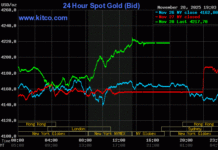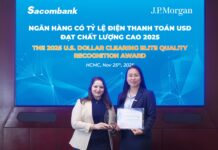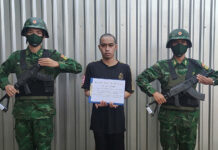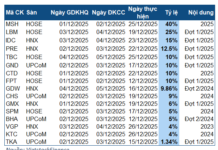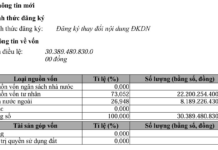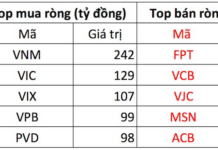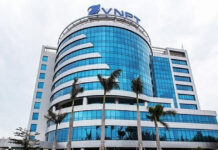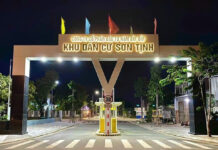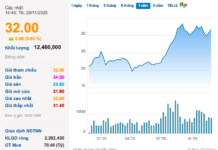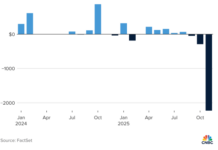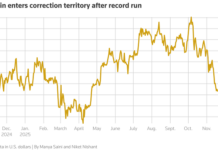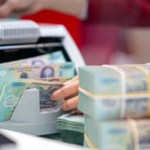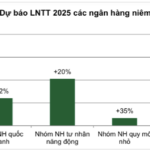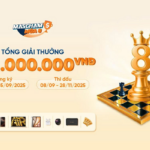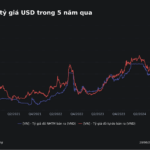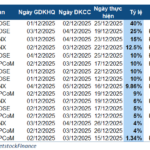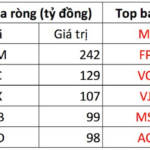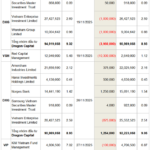Some banks increase lending rates
The State Bank has just announced the interest rate developments of credit institutions in July. Accordingly, the interest rate in the market is generally stable, with a clear trend in both deposits and lending.
In terms of mobilization, the interest rate of VND deposits at commercial banks is commonly at 0.1 – 0.2%/year for non-term deposits and those with a term of less than 1 month; 3.3 – 4.0%/year for the term of 1 to less than 6 months; 4.6 – 5.5%/year for the term of 6 to 12 months. For deposits of over 12 months to 24 months, the interest rate is at 4.9 – 6.1%/year; the rate for the term of over 24 months fluctuates between 6.9 – 7.3%/year.
Although the saving interest rate for a 12-month term remains below 6%/year at most banks, the slight increase in the mobilization interest rate recently will have a spillover effect on lending rates.
Most commercial banks have announced their average lending rates for July, with some banks increasing their lending rates compared to June, with the highest increase being 0.42%/year.
 Lending rates are on the rise.
|
The group of banks that increased their average lending rates in July compared to June includes: PGBank (up 0.42%/year) to 7.52%/year, Sacombank (up 0.32%/year) to 7.25%/year, BVBank (up 0.18%/year) to 8.82%/year, OCB (up 0.14%/year) to 7.86%/year, MB (up 0.02%/year) to 6.95%/year, and SCB (up 0.01%/year) to 5.4%/year.
On the other hand, the average lending rates of the four state-owned banks continued to slightly decrease and were listed at the lowest in the system. Specifically, Vietcombank’s rate was 5.6%/year, a decrease of 0.34%/year compared to June; BIDV was at 5.49%/year, a slight decrease of 0.01%/year; Agribank was at 6.5%/year, also a slight decrease of 0.01%/year; and VietinBank’s rate was 5.22%/year.
The group of small-scale banks has a relatively high average lending rate, above 8%/year, including Saigonbank (8.9%/year), Bac A Bank (8.61%), BVBank (8.57%/year), Viet A Bank (8.52%), PVCombank (8.29%/year), and KienlongBank (8.17%/year).
Lending rates are expected to increase
A group of experts from MSB Securities Company forecasts that by the fourth quarter, mobilization rates may slightly increase when credit growth tends to surge towards the end of the year, as this is the peak business season. Accordingly, the 12-month mobilization rate of large commercial banks is expected to fluctuate around 4.7%/year.
In addition to endogenous factors from mobilization activities, exchange rate pressure remains significant, and inflationary risks also impact lending rate hikes.
“We estimate that credit growth is about 1.3 – 1.5 times higher than capital mobilization growth. This has somewhat put pressure on mobilization interest rates in the private joint-stock commercial bank group to attract deposits,” said MBS analysts.
Financial and banking expert Nguyen Tri Hieu opined that, from now until the end of the year, mobilization interest rates tend to continue to rise to attract more capital from the people. Accordingly, lending rates are likely to increase. Moreover, when the exchange rate increases, banks are forced to consider not reducing the competitiveness of credit. Hence, adjusting lending rates becomes a tool to balance between pressure from the monetary market and the goal of maintaining credit growth.
Mr. Hieu said that lending rates would increase but are unlikely to surge as the Government and the State Bank require banks to strive to reduce costs to lower lending rates.
Ngoc Mai
– 05:30 30/08/2025
The Year-End Credit Sprint: Optimistic Expectations, Quality Assurance Needed
As we move into the final quarter of 2025, a surge in credit is expected, potentially surpassing the annual target set by the State Bank of Vietnam. This presents both opportunities and challenges for the financial and banking system. Experts emphasize the critical need to direct credit to the right sectors, primarily production and business, while effectively managing risks to ensure sustainable development.
The Vietnamese Stock Market: On the Verge of a Golden Growth Cycle
The VN-Index is surging towards the 1,700-point mark, accompanied by record-high market liquidity, with many sessions reaching 70,000 to 80,000 billion VND. This remarkable performance reflects investors’ strong confidence and the allure of the stock market, especially in the context of low-interest rates and tightened speculative real estate investments.
Why Are Exchange Rates Constantly Rising?
The State Bank of Vietnam (SBV) announced the reference exchange rate for August 28 at 25,268 VND per USD. Bank USD selling prices remained at the ceiling level of 26,531 VND/USD. The free market saw record highs for USD at 26,720 VND. Since the beginning of 2025, the Vietnamese dong has depreciated by 3.8% against the US dollar in the banking system and 3.4% in the free market.






